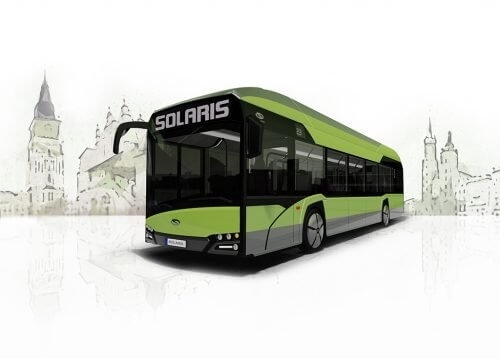Polish builder adds hydrogen fuel cell option to its range of environmentally-friendly vehicles

POLAND In response to growing interest within the European market in emission-free public transport vehicles, Solaris Bus & Coach has announced the debut of another environmentally-friendly option, the Urbino 12 hydrogen, which utilises a hydrogen fuel cell. The official premiere of the vehicle is slated for 2019.
The Solaris Urbino 12 hydrogen will be completely emission-free. Energy needed to power the driveline of the bus will be obtained from hydrogen that will be processed in a fuel cell to electric power.
Thanks to the technology used in the hydrogen buses, these will be able to cover a distance of over 350km on a single refuelling.
The vehicle will also be fitted with one of Solaris’ small 29.2kWh traction batteries that will support the fuel cell when the demand for energy is greatest.
The battery will be charged with hydrogen energy. In addition, it will be possible to recharge it by means of a plug-in charging outlet (as is the case in standard electric buses).
On the other hand, an axle with integrated electric motors, with a nominal power of 60kW each, will constitute the drive unit. The 12m bus will be able to carry up to 80 passengers.
The new generation Solaris Urbino 12 hydrogen represents the continuation and development of a concept which saw the light of day in 2014 for the first time, when two articulated electric Solaris Urbino 18.75 buses powered with hydrogen fuel cells as range extenders were delivered to Hamburg.
Batteries constituted the basic drive source of the buses showcased four years ago. In the new hybrid bus, electric energy propelling the vehicle will be derived from hydrogen, whereas the battery will only have a support function.
Solaris is using the latest hydrogen storage technologies, by installing tanks made of composites on the vehicle roof – thanks to this step the mass will be reduced by about 20% compared to previous models. In order to optimally reduce energy use in the vehicle, it will feature a climate comfort system with a CO₂ heat pump; the system will use waste heat from the fuel cell.
“The revolution in terms of green public transport has become a fact – Solaris has decided to respond to market demand with a whole new product,” said Dariusz Michalak, Vice-CEO of Solaris Bus &Coach, in charge of the research and development division.
“Hydrogen buses have the potential to be very popular on the market: they are cheap in use, lighter than electric buses, can cover a distance of 350km on a single hydrogen refuelling (that is also the average daily range of a city bus) and they are completely emission-free – the only substance emitted while the bus is driving is steam.”
Both fuel-cell-fitted Solaris Urbino 18.75 buses delivered to Hamburg in 2014 still cover bus route 109 on a regular basis. What is more, the Polish bus producer supplied the first trolleybus with fuel cells to Riga last year. Another nine are following this year.

